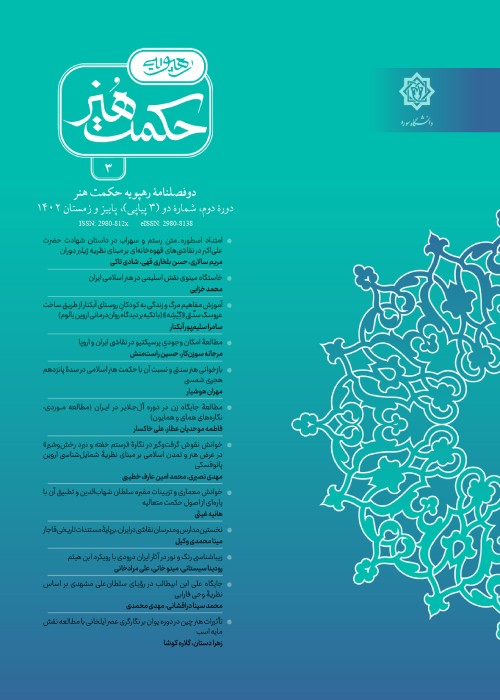Conceptualization of Highperformance Architecture Theory to Explain Revivalist Trends in Developing Countries
Author(s):
Article Type:
Research/Original Article (بدون رتبه معتبر)
Abstract:
The tendency towards "authenticity" has been considered more than ever in developing countries, especially in Islamic countries. Nowadays, revivalist trends have become one of the most important currents in the contemporary art and architecture of Islamic countries. The literature shows that these trends, in addition to their strengths, also had several weaknesses. In Iran, along with the other trends in the developing countries, revivalism acts as a dominant trend in the scene of contemporary architecture. Revivalist trends in Iran, in search of a contemporary expression, decided to establish an outstanding model of the Islamic Republic of Iran. The highperformance architecture theory as a futuristic phenomenon is to outline a future for the architecture of the world especially for the future architecture of the developing countries such as Iran. The context analysis show that Islamic countries of the West of Asia and the North Africa (MENA) region and other Islamic countries. As a leading architectural theory, the highperformance architecture theory is to outline a framework for the interaction of technology and prosperity in order to meet "excellence". The main goal of research is to find the similarities and differences of the proposed theory with other competing theories in the Islamic countries. The main purpose of this study is to reunderstand the revivalist tendencies in Islamic countries, and to analyze their strengths and weaknesses in comparison with the highperformance architecture theory. The methodology of the research is based on abduction and logical argumentation research strategy. Regarding the "designerly" character of highperformance architecture theory, the methodology of the research is to include theory and practice simultaneously. Based on the outlined goal, the results of the research can provide a framework for comprehensive policies in the field of art and architecture of Islamic countries. From a methodological point of view, the research examines the revivalist theories and practices in the art and architecture of Islamic countries with the logical argumentation strategy. For the reasoning process, the research has adopted the descriptive-analytical methodology. In analyzing the effects and procedures, it uses semantic content analysis and modeling methods. Research with a forward-looking futuristic approach, seeking to draw what is the desired model of art and architecture, at the level of the 20-year vision document of the Islamic Republic of Iran; as an inspiring model for other Islamic countries. Research findings show that both anti-technology and anti-traditional trends have been doomed to fail in the field of practice. These reactionary trends led to a kind of "extreme traditionalism" or "imitation architecture" in the contemporary architecture of the developing countries such as Iran. The results show a weakness in understanding the context in order to have a futuristic and a conceptual perspective toward the future. The recent trends suffer from lack of integrity and comprehensive understanding. The results are petro-dollars for a hasty pastiche architectural style in some developing countries which results in environmentally catastrophe and energy-hungry style of development.The conclusion of the research underscores that an essential shortcoming of the existing theories in the field of art and architecture of Islamic countries is the lack of practicality in the field of "design", and the weakness of comprehensiveness in the field of "technology". It highlights that a successful architecture theory has to criticize the extremist traditionalism and the imitation-eclecticism in order to find a way toward the future. The highperformance architecture theory has to respect the context in order to learn from indigenous identity, and to adopt the new technologies in order to meet the excellence in design. In this perspective, it could be an alternative for the future of art and architecture in Islamic countries as well as the developing countries.
Keywords:
Language:
Persian
Published:
Journal of Rahppoye, Hekmat-e Honar, Volume:1 Issue: 1, 2022
Pages:
27 to 38
magiran.com/p2519493
دانلود و مطالعه متن این مقاله با یکی از روشهای زیر امکان پذیر است:
اشتراک شخصی
با عضویت و پرداخت آنلاین حق اشتراک یکساله به مبلغ 1,390,000ريال میتوانید 70 عنوان مطلب دانلود کنید!
اشتراک سازمانی
به کتابخانه دانشگاه یا محل کار خود پیشنهاد کنید تا اشتراک سازمانی این پایگاه را برای دسترسی نامحدود همه کاربران به متن مطالب تهیه نمایند!
توجه!
- حق عضویت دریافتی صرف حمایت از نشریات عضو و نگهداری، تکمیل و توسعه مگیران میشود.
- پرداخت حق اشتراک و دانلود مقالات اجازه بازنشر آن در سایر رسانههای چاپی و دیجیتال را به کاربر نمیدهد.
In order to view content subscription is required
Personal subscription
Subscribe magiran.com for 70 € euros via PayPal and download 70 articles during a year.
Organization subscription
Please contact us to subscribe your university or library for unlimited access!


